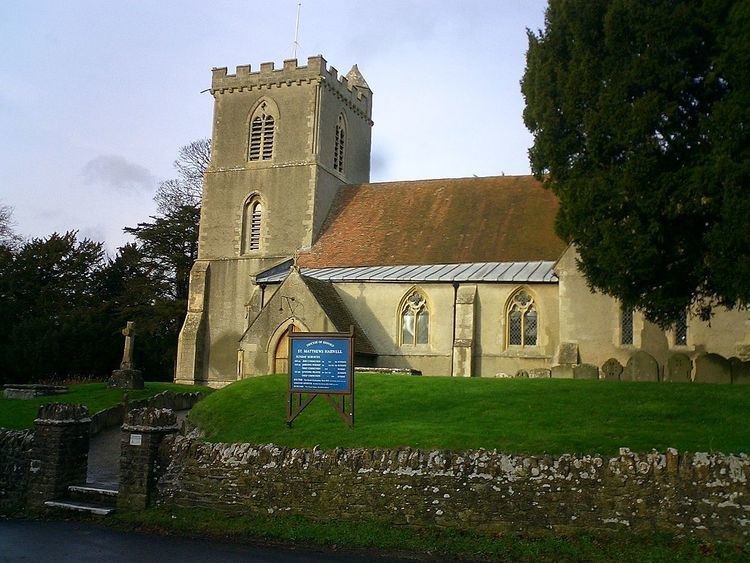Population 2,354 (2001 census) Sovereign state United Kingdom Dialling code 01235 | OS grid reference SU4989 Local time Friday 4:52 PM | |
 | ||
Weather 9°C, Wind W at 29 km/h, 70% Humidity | ||
Harwell is a village and civil parish in the Vale of White Horse about 2 miles (3 km) west of Didcot, roughly 6 miles (10 km) east of Wantage and approximately 13 miles (21 km) south of Oxford. It was part of Berkshire until the 1974 boundary changes transferred it to Oxfordshire.
Contents
- Map of Harwell Didcot UK
- Transport
- Parish church
- Economic and social history
- Airfield and Atomic Energy Research Establishment
- Notable residents
- Amenities
- References
Map of Harwell, Didcot, UK
Transport
Harwell benefits from several bus services including Thames Travel's X32 and 32A service between Oxford, Didcot and Wantage. Buses run up to every 30 minutes to Wantage and Oxford with buses between Harwell, Didcot and Harwell Campus running up to every 15 minutes during the daytime.
Parish church
The Church of England parish church of Saint Matthew may date from the 11th century. In 1962 The Times reported that walling had been found west of the tower indicating where a former nave had been. The herringbone layering of the masonry suggested that an 11th-century date is likely. At the same time a pewter chalice from about 1200 was found.
The present nave, east of the tower, was built in about 1200. This second nave has north and south aisles with three-bay arcades. The west tower may have been begun at the same time, but its Early English Gothic bell openings suggest that it may not have been finished until the middle of the 13th century.
The Decorated Gothic chancel is early 14th century and has a five-light east window. The rood screen is probably of the same date, but the screen's Perpendicular Gothic top is later.
The tower has a ring of eight bells. Joseph Carter, who was Master bellfounder at the Whitechapel Bell Foundry and also had a foundry at Reading, cast the fourth bell in 1590 and the seventh bell in 1597. William Yare of Reading cast the third and fifth bells in 1611 and the sixth and tenor bells in 1612. John Taylor & Co of Loughborough cast the treble and second bells in 1932, completing the present ring. St. Matthew's has also a Sanctus bell cast by Robert I Wells of Aldbourne, Wiltshire in the 18th century. There is a single-handed clock on the tower's west face.
In 1975 a two-storey extension was built on the north wall which now contains a parish office. A new church hall was built in 1994.
Economic and social history
The house at Middle Farm was a 14th-century hall house, and its service wing may be the remains of a 13th-century building. In 1589 an upper floor was inserted in the 14th-century hall and some pargeting was applied. One of the farm's barns has a cruck frame.
Geering Almshouses were built by a charity established in 1715 but the houses themselves may not have been built until about 1723. The almshouses are a Grade II* listed building.
Harwell once had five public houses and a brewery. The Crown is now empty, previously having been a nursing home. The Chequers, The Crispin and The Kicking Donkey have all been converted to private houses. Only The Hart of Harwell continues to trade as a pub and dining establishment.
On 4 April 1899 Police Constable John Charlton was killed in an affray outside the Chequers. His 2 killers were felled and arrested by another officer, PC Thomas Hewett and were later sentenced to 20 years hard labour for manslaughter
Two other general stores have closed in the village over the last 20 years, along with the village bakery.
Until the Second World War Harwell may have been best known for its cherry orchards.
Airfield and Atomic Energy Research Establishment
In 1937 RAF Harwell was built between Harwell and Chilton. The airfield was used in World War II to launch glider-borne troops for the invasion of Normandy.
In 1946 the airfield was taken over to be the new Atomic Energy Research Establishment, the main centre for nuclear power research in the UK, and become Harwell Laboratory. It was the site of Europe's first nuclear reactor in 1946, and once housed five nuclear reactors, all of which have been shut down. Two have been completely dismantled, and it is anticipated that the other three will be decommissioned by 2022.
Other parts of the airfield were later used by other scientific organisations, including the Science and Technology Facilities Council's Rutherford Appleton Laboratory which runs the ISIS neutron source and hosts the Diamond Light Source synchrotron joint venture. Part of the Atomic Energy Research Establishment is now operated by Research Sites Restoration Limited which is undertaking decommissioning work on behalf of the Nuclear Decommissioning Authority. The former airfield site as a whole is now called the Harwell Science and Innovation Campus and is managed by the Australian-based Goodman property group.
Notable residents
Amenities
Harwell's remaining public house, The Hart of Harwell, is on the corner of High Street.
The village has two shops: a butcher and a combined newsagent and off licence.
There are several clubs and societies in the village. These include a Royal Legion, a Scout Group, a Tennis Club, a Horticultural Society, Harwell Feast Committee, Harwell Rugby Club, football clubs, and others.
The Harwell Feast is a celebration held on the Monday of the May Bank Holiday each year. The celebrations include a parade of decorated floats and people through the village. The recreation ground hosts various fund-raising stalls and displays including sheepdog handling and historic cars. Either a cow or a couple of pigs are roasted for the feast.
